Bihar is one of the most flood-affected states of India. This has been a longstanding problem, but half-hearted flood control measures, and haphazard development plans have aggravated the problem.
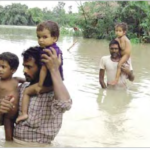 Thousands of people are missing in the catastrophe that had hit Bihar on August 18 after Koshi river changed its course and flooded hundreds of villages. Over one lakh people in 102 relief camps, about 2.5 lakh houses destroyed, crops in 1 lakh hectare wiped off, and while the government claims it has so far evacuated nearly three lakh people, the total number of population affected has swelled to 1.2 crore.
Thousands of people are missing in the catastrophe that had hit Bihar on August 18 after Koshi river changed its course and flooded hundreds of villages. Over one lakh people in 102 relief camps, about 2.5 lakh houses destroyed, crops in 1 lakh hectare wiped off, and while the government claims it has so far evacuated nearly three lakh people, the total number of population affected has swelled to 1.2 crore.
Monsoon floods are an annual event in eastern India, and are part of life for many people in the region. But on this occasion the river Kosi, which arises in Nepal, broke through an embankment and changed course, inundating six districts where people were unprepared for flooding. People have moved to any available high ground, abandoning their homes, possessions and livestock. Makeshift relief camps are operating. Road and rail routes in the flooded area are completely blocked. Rescue operations have been hampered by a shortage of boats. People are drinking unsafe water, and cases of diarrhoea have been reported.

Looking back
Like many other rivers of North Bihar, Kosi gathers water from Himalayas in Nepal. However, it is a trans-boundary river and flows between Nepal and India.Kosi is also one of the largest tributaries of Ganga and after flowing through nearly 70,000 sq kilometres confluences into Ganga near Kursaila in Katihar district of Bihar.
In Nepal, this river lies to the west of Himalayan peak, the Kanchanjangha and has seven major tributaries namely Sun Kosi, Tama Kosi, Dhudh Kosi, Indravati, Likhu, Arun and Tamar. That is why it is known as ‘Sapta Kosi’ in Nepal.This river has earned notoriety since time immemorial due to its unruly, turbulent and unpredictable behaviour. On an average, it carries 70-80 million tons of silt every year and it is perhaps due to this feature, it tends to change its course after a definite period of time. Kosi has an average discharge of 55,000 cusecs of water that increases by as much as twenty times during the monsoon or flood season, thereby assuming dangerous proportions.

Kosi and floods in Bihar have inseparable history, with the river being responsible for some of the most devastating floods caused in the state—from the one in 1954 to those in 1963, 1971, 1984, 1987, 1991, 1995 and the present flood in 2008.The initiative to tame sorrow of Bihar saw India sign the historic ‘Kosi Agreement’ with Nepal on April 25, 1954. While Gulzari Lal Nanda signed the agreement on behalf of the GOI, Nepal was represented by Bir Shumeshwar. The agreement envisaged setting up of a barrage by GOI. The barrage was to be located about eight miles upstream of Hanuman Nagar town; the barrage was built at Bhimnagar and it took over seven years (1956-63) to complete the work.
The terms and conditions of the agreement, however, stipulated that India would be responsible for the repair and maintenance of the barrage. The Government of Nepal also handed over the project area land on lease for 193 years.Other than the barrage, a 39 Kilometre long embankment from barrage site to Chatra in Nepal was also built to ‘jacket’ and tame the turbulence of this river. The ‘jacketing’ directed the flow of the river to the barrage and swift and fast Kosi was brought to control to a great extent.
Spurs—a diagonal structure to check the speed of current and protect embankment—were also constructed along the eastward embankment to prevent the erosion or breach in embankment.
While the jacketing of this river upstream barrage did prove successful in guiding and controlling the direction of the flow over the last 45 years, it was also moving towards becoming disastrous because of heavy siltation.As this river carries heavy silt with it, in due course of time the bed of the river rose above the field itself and this, in fact, has been the typical reason of flood every year in this area.
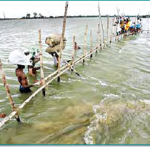 Unfortunately enough, while all previous floods in Kosi always happened due to breach in embankments downstream the barrage, the present flood has been caused due to breach in the embankment near Kusaha which is located upstream the barrage. According to reports available with sections of media, the signs of breach in this eastward upstream embankment were perceptible in the very first week of August itself.
Unfortunately enough, while all previous floods in Kosi always happened due to breach in embankments downstream the barrage, the present flood has been caused due to breach in the embankment near Kusaha which is located upstream the barrage. According to reports available with sections of media, the signs of breach in this eastward upstream embankment were perceptible in the very first week of August itself.
The current started eroding and damaging the embankment. The officials had said that the law and order situation in Nepal has under gone a change and they were not getting required amount of co-operation from the Nepalese authorities. They justified their alleged inaction by saying that when the team of engineers visited the site at Kusaha, they were not allowed to work and were forced to flee from the site.
Gradually, the spurs near Kusaha also got damaged and finally breached on August 18, 2008 . This site was about 12 kilometres away from the barrage, therefore within few hours waters flowed into the Indian territory.Although engineers tried to lessen the damage and control the discharge of water through the breach by opening 54 out of 56 sluice gates of the barrage, the current had by that time adopted a different course, making the attempt to prevent the disaster futile.
Relief work
A day after Prime Minister Manmohan Singh and UPA chairperson Sonia Gandhi made an aerial survey of the flood-affected areas in Bihar, the Centre moved its machinery into top gear to provide all possible assistance to the State government grappling with a grim flood situation.
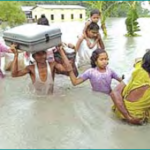 The Centre deployed four Army columns, five helicopters, 118 Boats and 624 National Disaster Response Force (NDRF) personnel. The Union Home Ministry said four more Army columns were being deployed. As much as 1.25 lakh tonnes of food grains has been allocated to the State. The Home Ministry spokesman said 3,732 tents and one lakh water bottles were sent to Bihar since Thursday. More tents and boats were being organised by the government.
The Centre deployed four Army columns, five helicopters, 118 Boats and 624 National Disaster Response Force (NDRF) personnel. The Union Home Ministry said four more Army columns were being deployed. As much as 1.25 lakh tonnes of food grains has been allocated to the State. The Home Ministry spokesman said 3,732 tents and one lakh water bottles were sent to Bihar since Thursday. More tents and boats were being organised by the government.
The Health Ministry is organising supply of two crore halogen tablets. The National Crisis Management Committee, headed by the Cabinet Secretary, reviewed the flood situation in Bihar. Relief Commissioners of West Bengal, Jharkhand and Orissa have instructed the magistrates of the districts neighbouring Bihar to provide boats as per the requirement of the State government. As announced by the Prime Minister, Rs. 1000 crore from the National Calamity Contingency Fund was released by the Centre.
The Ministry of Railways has issued sanction for transportation of relief material/fodder by rail from any station to notified flood-affected districts of Bihar for distribution in the affected areas. Officers of the Ministry of Home Affairs and the Control Room of the Ministry are in constant touch with the State government and monitoring the situation round the clock. ActionAid on its part has distributed tarpaulins and water-sterilising tablets from their existing stocks,An ActionAid team has also, been touring villages to assess the damage and the need for relief and reconstruction.
Looking Ahead
The flood, which has impacted over 30 lakh people in 1,700 villages in the state, has forced the Nitish Kumar government to realise that the impact of the Kosi’s change of course would have been much less if officials of the traditional flood belt of the state were posted there.
Yes, experience counts a lot during disasters, but India can’t afford to adopt unscientific disaster management modules to minimise impacts of repeated natural calamities. For a couple of days, flood victims in Bihar had no clue what to do, and more importantly what not to do. The Centre swung into action, but it was too late to stop the menace. Only on the 11th day of the tragedy centre announced an immediate release of Rs 1,000 cr, by the time large-scale damages were already witnessed.
 But a bigger tragedy for the country is its inability to put in place an effective nation-wide disaster management mechanism to contain impacts of natural calamities. If Indian-American Louisiana Governor Bobby Jindal could ensure an immediate evacuation of people in response to hurricane Gustav, why can’t Lalus and Nitishes fail to deliver the same on a scientific manner? In Bihar, the state administration must share the blame for its failure to meet the unexpected challenges, but the problem is actually rooted in the lack of proper mechanism to deal with such a situation. For Bihar’s disaster management flood came as a shock to the administration, but they finally tamed it. Technology has been a big help in tackling this flood. Bihar officials in the area were not that experienced to face such a flood fury. However, they got into action immediately. They managed to have the satellite images of the flood-hit areas which helped a lot in undertaking many logistics decisions.
But a bigger tragedy for the country is its inability to put in place an effective nation-wide disaster management mechanism to contain impacts of natural calamities. If Indian-American Louisiana Governor Bobby Jindal could ensure an immediate evacuation of people in response to hurricane Gustav, why can’t Lalus and Nitishes fail to deliver the same on a scientific manner? In Bihar, the state administration must share the blame for its failure to meet the unexpected challenges, but the problem is actually rooted in the lack of proper mechanism to deal with such a situation. For Bihar’s disaster management flood came as a shock to the administration, but they finally tamed it. Technology has been a big help in tackling this flood. Bihar officials in the area were not that experienced to face such a flood fury. However, they got into action immediately. They managed to have the satellite images of the flood-hit areas which helped a lot in undertaking many logistics decisions.
Significantly, the ministry of home affairs has a dedicated wing called national disaster management, but analysts say it’s grossly inadequate to face major disasters in a vast country like India. But the question here is how long India will wait to bring in scientific modes of disaster management.
Although the BJP-led National Democratic Alliance (NDA) government initiated a mammoth project to link rivers in India, but at present it is almost non-functional. The idea behind the project was to emulate China and link the rivers in such a way that excess water of one river basin could be diverted to another basin, thereby minimising the chances of both severe flood and drought. Also, corporate India has always played an important role in tackling natural calamities, but it was mostly confined to giving donations. Floods, landslides, droughts, earthquakes and other natural disasters are nothing new in India and yet still there doesn’t seem to be a default arrangement for dealing with these problems.
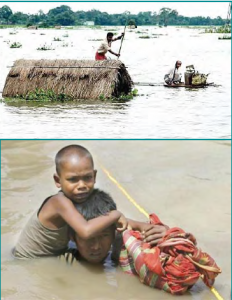 Given the frequency of these events – and most scientists seem to be predicting that extreme weather events are on the increase – it’s amazing that India doesn’t have effective federal-level disaster relief teams, with supplies and equipment, on permanent standby. This might sound like a big ‘ask’ but in reality it only requires the stockpiling of required supplies and the training of some military units to be ready to be redeployed in relief mode (as their secondary function) when disaster strikes.
Given the frequency of these events – and most scientists seem to be predicting that extreme weather events are on the increase – it’s amazing that India doesn’t have effective federal-level disaster relief teams, with supplies and equipment, on permanent standby. This might sound like a big ‘ask’ but in reality it only requires the stockpiling of required supplies and the training of some military units to be ready to be redeployed in relief mode (as their secondary function) when disaster strikes.
However, its worth remembering that the mighty United States of America fared little better when Hurricane Katrina struck New Orleans three years ago.There are obvious of parallels between the two disasters. Warnings about the poor maintenance and breach of the New Orleans levees were issued and ignored with catastrophic consequences, just as they have been over the Kosi barrage in Nepal which India was supposed to be maintaining.And when the scale of their folly became clear, the Louisiana and US federal governments played the blame-game just as the authorities in Patna and New Delhi have done.But this is where the similarities might end. America learned from its mistakes, as could be seen by the evacuation of two million people from the Big Easy this week as Tropical Storm Gustav bore in from the Atlantic.
This is not to say India should have evacuated three million people from Bihar – that’s clearly impractical in the Indian context – but it is surely time the better plans were laid at Central level.
So will India learn lessons? Will the Bihar floods of 2008 be a ‘Katrina moment’ when the state woke up to its obligations and put in place the contingency plans required to deal with these kinds of disasters?Let us sincerely hope so, but on past form, you’d be a brave man to bet on it.
Bihar before and after Floods
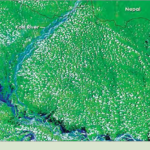 Monsoon rains regularly swell rivers in northern India, but in 2008, the Kosi, a tributary of the Ganges and a major river in its own right, did something different. It burst through its banks to flow into a channel it had abandoned more than 200 years ago. The flooded channel swept over a region not accustomed to flooding and forced more than a million people from their homes. The flood is clearly visible in these images, collected by the Moderate Resolution Imaging Spectroradiometer (MODIS) on NASA’s Terra satellite on August 24 and August 8 .
Monsoon rains regularly swell rivers in northern India, but in 2008, the Kosi, a tributary of the Ganges and a major river in its own right, did something different. It burst through its banks to flow into a channel it had abandoned more than 200 years ago. The flooded channel swept over a region not accustomed to flooding and forced more than a million people from their homes. The flood is clearly visible in these images, collected by the Moderate Resolution Imaging Spectroradiometer (MODIS) on NASA’s Terra satellite on August 24 and August 8 .
On August 8, the braided channels of the Kosi River curved westward out of Nepal in a “c” shape before flowing into the Ganges (below the lower edge of the image, visible in the large image). On August 24, the Kosi cut due south, bypassing the previous arc formed by the river’s modern channel. The flooded channel was kilometers wide in places. Water still flowed through the modern channel on August 24, but the river seemed smaller than it had two weeks earlier.
Images such as these are useful in assessing the overall extent of a disaster. In this type of  image, water is usually dark blue and black. Both sediment-laden water and water-saturated earth are a lighter shade of blue. The channels of the Kosi are silvery from reflected sunlight. Large towering rainclouds in the image are pale blue, while lower-altitude, warmer clouds are white. The plant-covered land is bright green.
image, water is usually dark blue and black. Both sediment-laden water and water-saturated earth are a lighter shade of blue. The channels of the Kosi are silvery from reflected sunlight. Large towering rainclouds in the image are pale blue, while lower-altitude, warmer clouds are white. The plant-covered land is bright green.
ICT: Need of the Hour……
Community Radio: Community radio can be a blessing in disguise for the state like Bihar where the development has taken a back seat due to political apathy and hypocrisy. The Community Radio Forum, India and its partner organizations has recently propose to set up temporary radio stations in the flood affected areas of Bihar to assist the local administration and provide the flood affected people with vital information through radio broadcasts on Critical Flood and Emergency Warnings – to alert people in advance of possible further threat(s) in order to help them take preventive measures and/or direct them to safer areas, Missing Person alerts – Hundreds of families have been separated in the flood emergency, with an unknown number of people missing, especially children. Emergency radio stations can play an important role in identifying and reuniting these families, Information on Relief Measures- including information on locations and time of relief material distribution, medical camps etc, Health alerts – for evacuees/flood victims, including epidemic warnings, medical safeguards and first aid, sanitation and hygiene information, location of medical camps etc. and Providing Accurate Information – Countering unconfirmed information and rumors that can trigger panic among an already disturbed population. It becomes vitally important to maintain the flow of authentic and reliable information.
Also, It can trigger much desired change in the society with its potential to empower people with local, adequate and relevant information necessary to make decisions in day to day life. Information is the key. If people have the right information, they can act prudently, thereby freeing themselves from the practices that bring misfortune to their lives.
Ham Radio: It can act as a blessing is disguise during hours of distress like the Bihar floods.The national association of ham radio operators, and police ham operators in other states, should be requested to station themselves in district headquarters and visit affected villages on day trips on motorboats to provide the most valuable commodity missing in remote areas – communication. They can assess where help is needed, and it can be reached there quickly in a sharpshooter approach.
Cell Phones: Though there was lot of congestionin mobile networks during the floods but it was only mode of communication fully functional during floods. Mobile phones have helped save hundreds of stranded people in flood-ravaged Bihar. People were able to contact the local administration using their mobile phones. Families received food packets as relief and were rescued from rooftops after they sent SMSs and called the administration in Supaul district. People exchanged messages to inform their kin about their safety and location.
According to Bihar disaster management minister Nitish Mishra, cellphones helped keep hope alive for people who are still stranded by the flood, one of the worst in the state in 50 years. He said that he received messages from at least 200 people requesting help.Local authorities received SMSs which explained their situation. Some said that they would die of starvation on rooftops without timely help, saying that time was running out for them. Several women used mobile phones to contact their husbands who were in neighbouring states. When all other methods of communication, including landline phones, failed, mobile phones became the lifeline for hundreds affected by the floods. People were cautious enough to conserve the batteries of their mobiles as there was no way to charge them.
Landline Phones:Though Bihar has more than 9 lakhs landline connections but during the recent floods they were all rendered useless. No one can be blamed for it because the water had entered the telephone exchanges and also the cables were severely damaged.
Satellite Phones: In addition to the 4 Satellite phones already provided, 10 more satellite phones are being provided to state machinery for speeding up the relief work.
Be a part of Elets Collaborative Initiatives. Join Us for Upcoming Events and explore business opportunities. Like us on Facebook , connect with us on LinkedIn and follow us on Twitter, Instagram.











